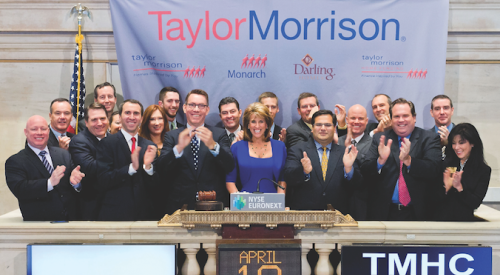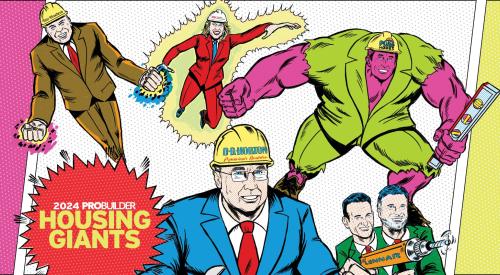|
It's doubtful we'll hear any builders brag about their performance in the 2009 Annual Report of Housing's Giants. Most are losing money — even those on the rise in the rankings. Still, this report provides a fascinating snapshot of America's housing industry as 2008 ended.
By then, casualties of housing's apocalyptic crash included not only many ranked giants but the entire American mortgage finance system — including Fannie Mae and Freddie Mac, the government-sponsored enterprises at its heart. This magazine started its research looking for the customary Giant 400, but we found only 350 production builders during our three-month survey period, even when we cast a net for firms with as few as 50 closings.
Attrition is the key change in the 2009 giants. Even lowering the threshold to just 50 closings, only 350 firms made it, and they are a lot smaller than the giants of earlier years.
It's certainly a stretch to call No. 350, John Kavanagh Co. of Greensboro, N.C., a giant. The firm recorded only 55 closings for $7.9 million in 2008. In 2006, Lockwood Construction of Bingham Falls, Mich., was the smallest company on the list with 156 closings for $14.7 million. And John Kavanagh folded his business last month. "The market just totally dried up," he told The Business Journal of the Greater Triad Area.
Kavanagh is not the only ranked builder now out of business. Glance down the 2009 giants list (online at www.probuilder.com/giant400) and you'll find prominent companies such as No. 32 Mercedes Homes of Melbourne, Fla. (filed for Chapter 11 protection in January, 2009), and No. 34 WCI Communities, the Bonita Springs, Fla.-based public company (filed in August last year). The 2004 PB Builder of the Year WL Homes of Newport Beach, Calif., was the No. 22 builder as recently as two years ago, but it dropped to No. 51 this year — and filed in February 2009. These companies are still in the rankings because they closed homes and booked revenue in 2008. But their presence reinforces that attrition is the story.
A New Top 5
In every big housing recession, a Top 5 builder seems to go down. (In 1992, U.S. Home Corp. filed under Chapter 11.) It finally happened in this crash, when No. 1 Pulte Corp. of Bloomfield Hills, Mich., recently announced it will purchase Dallas-based No. 3 Centex Corp. in a straight stock deal set to close later this year (go to HousingZone.com for complete coverage). But for our rankings that cover 2008, those two are still in the Top 5 with Fort Worth, Texas-based No. 2 D.R. Horton and Miami-based No. 4 Lennar Corp.
However, Reston, Va.-based public builder NVR, the darling of the housing stock analysts, makes a big splash this year by climbing from No. 7 to No. 5 — with $3.6 billion in revenues from 10,741 closings in 2008 — at the expense of Los Angeles-based KB Home, which dropped all the way to No. 8 ($2.9 billion from 12,438 closings). SEC filings show NVR even made money in 2008 ($101 million), while the rest of the Top 5 lost a combined $5.8 billion, about 80 percent of that in land impairments. No wonder most of the public builders are trying to remake themselves to look more like NVR, which owns no land and has virtually no debt.
 2009 Giants still built mostly single-family detached houses last year and derived an even higher percentage of revenues from detached homes.  But U.S. Commerce Department data shows rental housing up and single-family production down. No wonder apartment builders dominate the list of giants with increasing revenues. |
The implosion of the big public builders in the last three years is mind-boggling. Pulte had $5.98 billion in 2008 revenues, edging D.R. Horton ($5.44 billion), even though D.R. Horton beat it in closings 23,915 to 21,022. But three years ago, Pulte closed 45,630 homes for $14.37 billion and D.R. Horton had 51,383 closings for $13.72 billion.
Just in the last year, Pulte's revenue is down 32.7 percent, Horton's 43.1 percent, Centex's 42.5 percent and Lennar's 56.1 percent. Even NVR is off 27.9 percent in revenue.
Texans, Rental Builders Still Moving Up
A year ago, we noted the extreme volatility the housing crash imposed on the giants' rankings, and it's still there. Some 184 giants rose 10 positions or more (even though many lost ground in revenues and closings), 58 firms dropped 10 positions or more, while 33 dropped out of the rankings entirely.
Another trend from a year ago is also still in place: the ascendance of Texas builders and rental housing producers.
For instance, Arlington, Texas-based Wall Homes, identified as a shooting star a year ago, continued its meteoric rise from No. 171 last year to No. 81 in 2009, but filed for Chapter 11 protection in January this year. But the housing recession is not as severe in Texas. Giants that build only in that state are down 22.3 percent in revenue, compared to 39.1 percent for builders operating entirely outside Texas.
Meanwhile, of the 33 Giants that actually increased revenues over the past year, nine of the Top 10 were rental builders. Included is this year's most notable shooting star: AvalonBay Communities, an Alexandria, Va.-based real estate investment trust (REIT) that rose from No. 57 to No. 17 by pushing up production 130.8 percent (from 1,749 to 4,036 units), and revenues up 137 percent to $1.04 billion.
 |
Movers and Losers, But Not Many Winners
If we ranked housing's giants on 2008 profit, we'd have a short list. Many companies making big jumps lost ground in revenues and closings. They're not profitable either, but they look like survivors. Those that dropped have to be in trouble.
 Big retreats mostly happen to builders in states where speculative pricing bubbles burst, such as Florida, California and Arizona.  They're all rental apartment builders except for LGI Homes and True Homes. LGI Homes, a Texas entry builder, made a small upward move in units (434 to 475) and revenue ($59 million to $63.4 million) to spike 115 places to No. 163. |
The closer to the top, the harder it is to move up — so advances of NVR (No. 7 to No. 5) and Scottsdale, Ariz.-based Taylor Morrison (No. 13 to No. 10) are significant, even though both retreated in units and revenue. Taylor Morrison CEO Sheryl Palmer says she doesn't buy the idea that the first-time buyer market segment is the place to be. She favors site-specific analysis: "We were aggressive," she says. "We started to re-position early and had new product on the ground in 2007. In some places, we re-positioned away from entry product simply because everybody else was jumping into it."
Smaller, Smarter Move-Up Houses?
Atlanta move-up maven John Wieland rose five spots (No. 42 to No. 37) even though his closings dropped from 1,106 to 711 and revenues from $582.7 million to $400 million. To survive, he says he's managing cash carefully and marketing that now is a great time to buy. "We're also getting fresh architecture out there," he says. "It's got to be smaller. The age of conspicuous consumption is over."
Canadian Dough Rising
Now headquartered in Winter Park, Fla., the U.S. division of Canadian giant Mattamy Homes moved up (No. 117 to No. 68) on the strength of infusions of capital from north of the border. "We have a strong parent," says U.S. Division President Steve Parker, who's been on a land-buying spree in Central Florida. Mattamy also operates in the Carolinas, Minnesota and Arizona.
Look for Mattamy to move into Tampa, Fla., and Raleigh, N.C., soon. "We're positioned to grow with low-cost land as U.S. markets recover," Parker says, "but we'll do it in cities close to where we are now."
Most of the big public builders are still singing the land impairment blues, partly because they act much more like land developers than home builders. Their business model is broken beyond repair, but they don't know how to fix it. The only way they know to make money is by adding value to land.
That's why they continue to write down land assets that should have been dumped years ago. David Goldberg, housing stock analyst for UBS Securities, chronicles the total impairments at the end of 2008 for the top four builders (NVR doesn't play this game):
No. 1 Pulte: Total on-balance-sheet impairments of $3.5 billion, $424 million in write-offs of land deposits and pre-acquisition costs, $303 million in impairment charges related to land held in joint ventures. Also includes goodwill write-off of $375 million. Percentage of book value: 46.
No. 2 D.R. Horton: $3.8 billion of impairments on owned lots and $345 million from the forfeiture of option deposits and pre-acquisition costs. Also includes $553 million of goodwill impairments. Percentage of book value: 48.3.
No. 3 Centex: $3 billion from land impairment charges (including $327 million in joint ventures), $524 million from the forfeiture of option deposits and pre-acquisition costs and goodwill of $116 million. Percentage of book value: 46.5.
No. 4 Lennar: $2.6 billion of inventory adjustments (including $860 million from joint ventures), $787 million of write-offs of option deposits and goodwill write-offs of $217 million. Excludes $740 million loss related to sale of land to Morgan Stanley Real Estate. Percentage of book value: 40.
No wonder the largest public builders want to morph into NVR, but they can't do it just by changing their land strategy. The NVR model is really about manufacturing and distribution, not just buying lots on rolling options.
Broken Business Model
Goldberg believes the largest public builders are near the bottom of the land impairment cycle, because home price-cutting is near its end. "When you stop cutting prices, you get a break on impairments," he says, "because it's non-discounted cash flow you're starting with. ... But it won't be totally over for a couple of years."
All the public builders have migrated down in price, Goldberg says. Many are now back in the entry market.
"But the bigger issue is, where do you find a business model that will function again?" he asks. "Right now, builders can't buy raw dirt, develop it, pay all the entitlement fees, build a house and sell the house and lot for positive cash flow. The only way you can make money is by buying the land at a big discount, and that won't work for long. Something has to change structurally — maybe higher densities, lower fees and smaller homes."
  |
In addition to asking builders to detail what kind of houses they build, how many they close and the revenues they book, PB also asks what worries them in the middle of the night and what excites them when they contemplate the future.
It should come as no surprise that lots of things are going bump in the night these days. The economy is the largest general concern, followed by more specific worries about finding room for a profit margin in still-declining home prices, and finding a sales strategy that works. Beyond those big three, all the other challenges seem trifling.
Obviously, land issues are still a concern for some of the largest public builders, who are still taking impairments, but most private builders either got past those issues or left the business. But when we call builders looking for more detail on what concerns them, it's like opening Pandora's Box. It doesn't take long for politics to come up. "The restriction of the federal tax credit to first-time buyers makes no sense," says Toll Brothers Chairman Bob Toll. "The government should want to stimulate home buying wherever it can. That's why the California tax credit is working better than the federal one. To disadvantage one part of the market over another is silly."
A number of builders turn quickly to that subject. "It's all well and good to say the starter market is where the action is, but what good does that do us?" asks Atlanta builder John Wieland. "We've been building move-up houses for 40 years. How could we change? It's impossible." He's critical of changing banking rules. "It looks like one hand doesn't know what the other is doing, the way the recent reversal on mark-to-market undercuts the new PPIP program for toxic assets."
Kim Shelpman, CEO of Melbourne, Fla.-based Holiday Builders, is in the entry market, yet she echoes Bob Toll in her criticism of the federal government for not targeting new-home construction for stimulus: "We've always used housing stimulus to get out of recessions. What other choice is there?"
Housing always leads recovery, Toll says. "Housing is the fastest way to increase employment," he argues. "Housing employs more people faster, and it has a much greater multiplier effect. Nobody buys furnishings for a bridge!"
Many Builders Positioning for Breakout Opportunities
Builders free of debt with cash at hand are getting anxious to see more land assets hit the market from banks still holding them. "We're in a land-buying mode," says Tom Krobot, president of Roswell, Ga.-based Ashton Woods Homes, which climbed from No. 50 to No. 39 in this giants ranking, thanks in part to a big presence in Houston and Dallas markets that are performing better than Ashton Woods' other operations in Florida and Arizona. "But the lots have to pencil," he cautions.
"Right now, the lots that are worth 30 cents to 40 cents on the dollar, the banks want 60 cents. And the rules change every week," Krobot complains. "First there was TARP money, now it's PPIP. The banks won't sell the land until the rules stop changing."
|

















